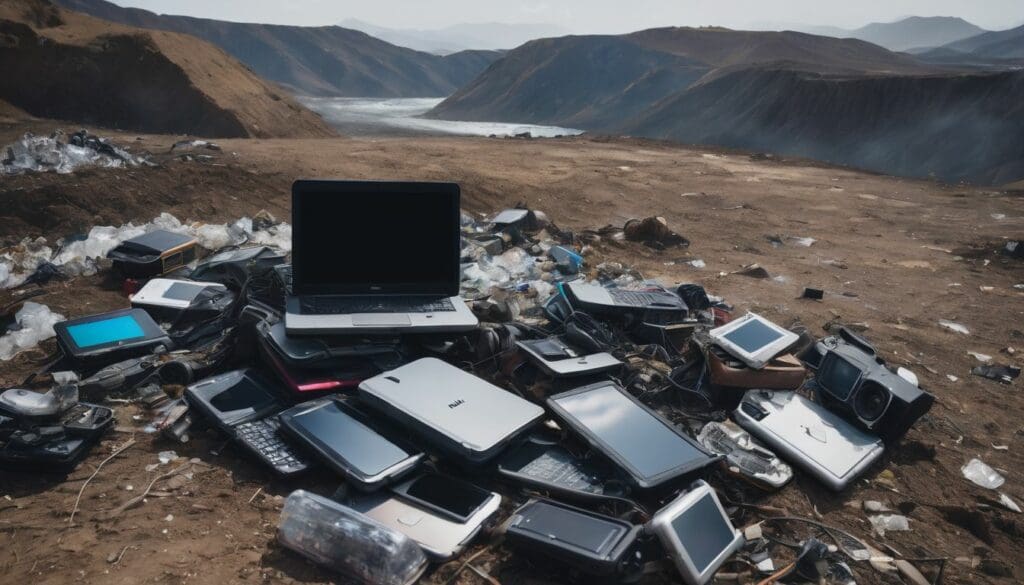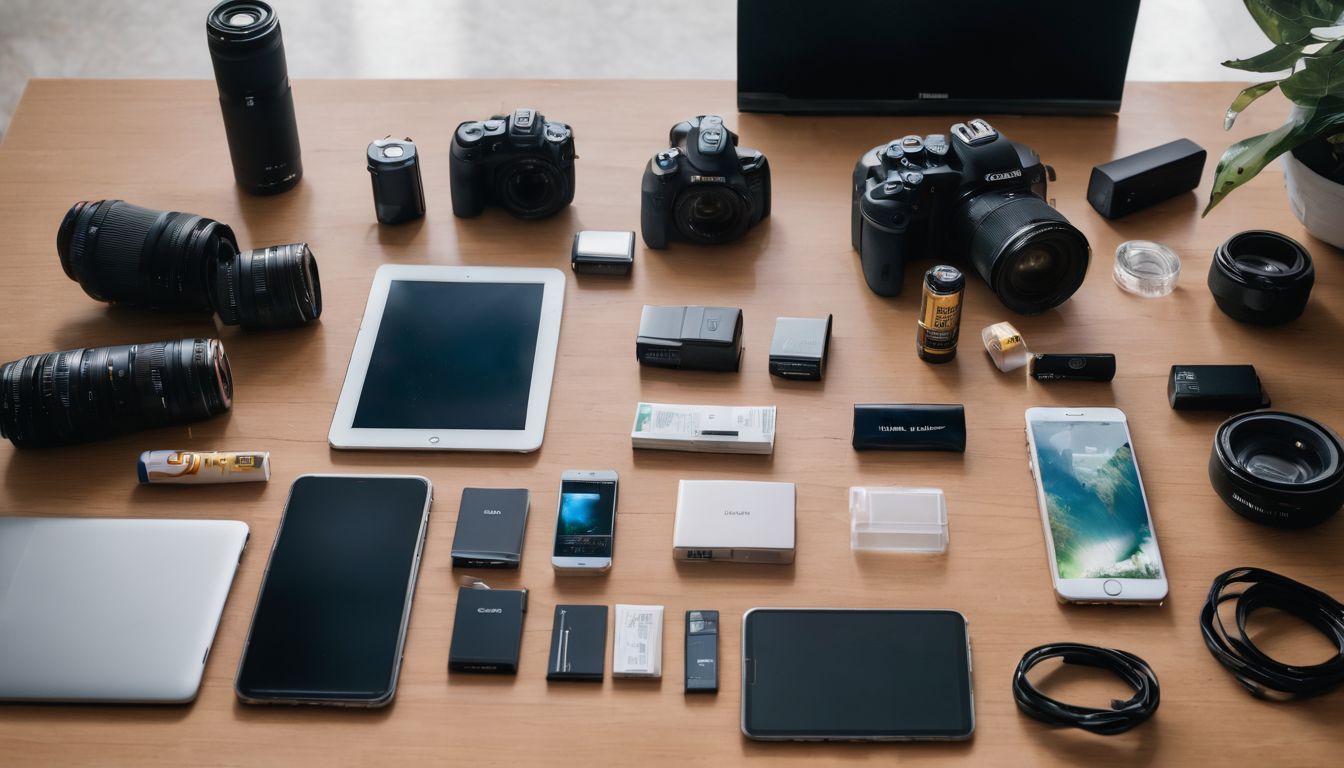We all know the feeling, agonising over the decision to upgrade our cherished tech companions. Much like you, we understand that twinge of reluctance when it comes time to bid farewell to a trusty device; were you aware that the typical smartphone only has a lifespan of around 2-3 years? Our in-depth research explores this cycle and its implications for both us as individuals and our environment.
Peruse our findings to uncover how your approach to technology could evolve into something far more sustainable – let’s decipher this puzzle together, shall we?.
Key Takeaways
- The typical lifespan of a smartphone is only 2-3 years, highlighting the importance of understanding the lifecycle of consumer electronics for sustainable usage and environmental impact reduction.
- Consumer electronics go through four main life cycle stages: introduction, growth, maturity, and decline. Each phase has implications on production scales, market strategies, and environmental conservation efforts.
- Design considerations such as durability and repairability along with material selection for sustainability are essential in extending product lifespans and reducing electronic waste.
- Technological advancements often lead to obsolescence but can also be leveraged to improve product sustainability by enhancing energy efficiency or incorporating eco-friendly materials.
- User behaviour significantly influences the lifecycle of electronics; responsible usage, maintenance, disposal practices help extend device longevity and minimise environmental damage.
The Importance of Understanding the Lifecycle of Consumer Electronics
As we dive into the world of consumer electronics, grasping their lifecycle is crucial for several reasons. It helps us predict how long our devices will last and informs us about the environmental impact they carry from creation to disposal.
Understanding this cycle guides manufacturers in designing more sustainable products that align with conservation efforts while catering to your needs as a tech-savvy consumer.
Knowing each stage of an electronic product’s journey empowers us to make informed choices. We can choose gadgets that boast longer lifespans, encourage producers to minimise waste, and support recycling initiatives.
This knowledge also shines a light on planned obsolescence—the practice where devices are intentionally designed to have a limited useful life—prompting us to advocate for durable and repairable products.
By keeping tabs on the technology lifecycle, we stand together as responsible guardians of both innovation and our planet’s future.
The Four Phases of the Product Life Cycle
The product life cycle consists of four stages: introduction, growth, maturity, and decline. Understanding these phases is crucial for effectively managing the lifecycle of consumer electronics.
Introduction
Consumer electronics play a significant role in our daily lives, but have you ever considered the impact of their life cycle on the environment? Understanding the lifecycle of consumer electronics is crucial for making informed choices as environmentally conscious individuals.
Throughout the stages of introduction, growth, maturity, and decline, electronic products have varying impacts on natural resources and waste generation. By delving into this subject, we can gain insights into sustainable practices that align with conservation efforts while ensuring that our technological needs are met.
Now let’s explore the importance of understanding each phase in more detail – The Four Phases of the Product Life Cycle.
Growth
As we move from the introduction to the growth phase, consumer electronics start gaining traction among users. During this period, demand for electronic gadgets increases significantly, and manufacturers scale up production to meet the rising market needs.
Innovations and improvements are frequently introduced to keep pace with technological advancements, attracting a larger customer base and enhancing product utility. This phase is characterised by aggressive marketing efforts as companies strive to capture a larger market share and establish their brand in the industry.
Technological advancements drive rapid product development during this stage, leading to dynamic changes in consumer tech products. As demand continues to grow at an exponential rate, sustainable design practices become increasingly relevant in managing end-of-life phases of electronic devices effectively.
Maturity
Transitioning from the growth phase, the maturity stage of a consumer electronics product marks a period of stability and saturation in the market. During this phase, sales typically level off as the product reaches its peak popularity and market penetration.
Manufacturers focus on maintaining their market share through competitive pricing strategies and seeking opportunities for product differentiation to stand out from competitors. Simultaneously, environmentally conscious individuals can play a critical role by choosing products that have sustainable design features and longer lifespans, contributing to mitigating electronic waste while supporting conservation efforts.
As products enter their maturity phase, it becomes crucial for consumers to consider factors such as repairability, upgradability, and recyclability when making purchasing decisions.
By prioritising durability and eco-friendly design elements in consumer electronics during this stage, individuals can promote responsible consumption while extending the lifespan of electronic devices.
Decline
As products reach their maturity stage and consumer demand begins to stabilise, they eventually enter the decline phase of the product life cycle. During this period, sales and profits start to decrease as newer technologies or innovations capture consumers’ attention.
The gradual dwindling in demand for these consumer electronics initiates a shift towards strategies for managing end-of-life phases and finding sustainable disposal methods. Additionally, manufacturers may also need to consider offering repair services or repurposing options to extend the lifespan of these products and minimise electronic waste.
Amidst this phase, reevaluating design considerations becomes crucial in order to prolong the usefulness of electronic devices while reducing environmental impact. This warrants thorough assessments regarding material selection and manufacturing processes that contribute to extended product lifespans.
Factors That Impact the Lifecycle of Consumer Electronics
Design considerations such as durability and repairability, material selection for sustainable sourcing and recyclability, technological advancements that drive obsolescence, and user behavior that influences the lifespan of electronics.
These factors are crucial in understanding the environmental impact and sustainability of consumer electronics.
Design considerations
When considering the design of consumer electronics, it is essential to prioritise energy efficiency and sustainable materials. Using eco-friendly components and ensuring streamlined manufacturing processes can significantly reduce the environmental impact of electronic devices.
Incorporating modular designs also allows for easier repair and upgrading, extending the lifespan of products and reducing electronic waste in line with conservation efforts.
Furthermore, designing products with minimal packaging reduces material waste while promoting responsible consumption among users. Implementing these design considerations not only aligns with our environmental values but also contributes positively to the lifecycle assessment and management of consumer electronics within the industry.
Material selection
After considering the design aspects, we move onto material selection. The choice of materials profoundly influences the environmental impact and lifespan of consumer electronics. When assessing materials, factors such as recyclability, energy consumption during production, and the environmental impact of mining or extraction processes are crucial.
We must opt for sustainable materials that reduce waste and energy use throughout the product lifecycle. Keywords like life cycle assessment and electronic equipment lifespan play a significant role in determining suitable materials for environmentally conscious individuals.
Material selection significantly impacts our ability to produce long-lasting, environmentally friendly consumer electronics. By considering keywords like life cycle assessment and product lifecycle management during material selection, we can make informed choices that align with our values about conservation.
Technological advancements
Technological advancements continuously shape the consumer electronics industry, influencing every phase of a product’s lifecycle. Innovations in materials and production processes enhance the durability of electronics, prolonging their usefulness and reducing waste.
Additionally, advancements in energy-efficient designs and eco-friendly manufacturing contribute to more sustainable product lifecycles, aligning with our commitment to environmental conservation.
Throughout a product’s growth and maturity phases, technological advancements drive improvements such as longer battery life or faster processing speeds. These enhancements not only improve user experience but also extend the lifespan of consumer tech products, reducing the frequency of upgrades and ultimately lessening electronic waste.
User behavior
Understanding the impact of user behaviour on the lifecycle of consumer electronics is crucial for environmentally conscious individuals. Users play a significant role in determining the lifespan and environmental impact of electronic goods.
How users engage with their tech gadgets, handle upgrades, and discard obsolete devices directly influences the overall product lifecycle. The ways consumers interact with connected devices also affect the end-of-life phase and can contribute to sustainable practices or environmental harm.
Examining user behavior provides valuable insights into how to extend the sustainability of consumer technology. By understanding how consumers use, maintain, and dispose of their electronic products, we can develop strategies that support conservation and environmental responsibility throughout every phase of an electronic product’s life cycle.
Strategies for Effective Marketing and Product Development
Implementing sustainable design practices and managing the end-of-life phase are crucial strategies for consumer electronics companies looking to reduce their environmental impact.
Find out how these strategies can benefit both the environment and your bottom line in our upcoming blog post!
Using the product life cycle model
In marketing, using the product life cycle model helps us understand where a consumer electronic product stands in its lifecycle. By recognising whether a product is in the introduction, growth, maturity, or decline phase, we can tailor our strategies to meet the needs of both consumers and the environment.
This approach influences everything from production to end-of-life management as sustainable design practices become essential for mitigating environmental impact.
Implementing sustainable design practices means considering all stages of a product’s lifecycle. It allows us to create products with longer lifespans while reducing their overall environmental footprint.
Implementing sustainable design practices
- Utilising environmentally friendly materials in product construction.
- Reducing energy consumption during manufacturing processes.
- Designing products with modular components for easier repair and upgrade.
- Integrating recyclable materials to ease disposal at end-of-life phase.
- Employing eco – friendly packaging to minimise waste.
- Considering the entire product lifecycle, from extraction of raw materials to end-of-life disposal.
Managing end-of-life phase
- Promoting consumer awareness on e – waste management options.
- Collaborating with recycling facilities to ensure proper disposal of electronic components.
- Developing take – back programmes to facilitate the return of old electronics for recycling or refurbishment.
- Advocating for extended producer responsibility to hold manufacturers accountable for product disposal.
- Encouraging eco – friendly design through easily recyclable materials and modular construction in product development.
Conclusion
Gaining insight into the lifecycle of consumer electronics is crucial. Understanding the four phases can guide strategic decision-making. Factors like design, material selection, and technological advancements impact this lifecycle significantly.
Implementing effective marketing strategies and sustainable practices can enhance product longevity and minimise environmental impact.
FAQs
1. What is the lifecycle of consumer electronics?
The lifecycle of consumer electronics involves stages from design and manufacture to use by consumers and reaching the end-of-life phase where they are recycled or disposed of.
2. Why is it important to understand electronic product lifecycles?
Understanding electronic product lifecycles helps businesses develop marketing strategies that match each stage, considering consumer behavior and the shrinking lifespan of tech products.
3. How long do consumer tech products usually last?
Consumer tech product lifespan can vary, but recently they’ve been getting shorter as technology advances rapidly and new models replace older ones more frequently.
4. What happens during the end-of-life phase for electronics?
During the end-of-life phase, electronics are either repurposed, recycled, or disposed of responsibly to reduce environmental impact and make way for newer technology.





